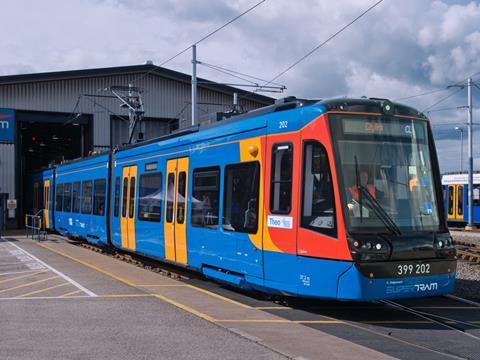
UK: Passengers aboard the 10.35 departure from Rotherham Parkgate on October 25 made history as they rode the first tram-train in revenue service in the UK.
Opening of the Sheffield – Rotherham tram-train route marks the culmination of a pilot programme more than a decade in the making which aims to evaluate the potential for tram-train operation in Britain.
The Sheffield Supertram light rail network has been linked to the national rail network via a new 160 m chord at Tinsley, near the Meadowhall tram terminus. From Tinsley, tram-trains use an upgraded and electrified section of former freight-only line to serve the existing station at Rotherham Central and a new stop at Rotherham Parkgate.
‘Today marks the first extension of Supertram to open since 1994, and we are pleased to be able to take the network beyond Sheffield to wider South Yorkshire and tap into some important commuter flows’, said Tim Bilby, Managing Director of operator Stagecoach Supertram.
The government-funded tram-train pilot project has been developed by a partnership of transport authority SYPTE, infrastructure manager Network Rail, Stagecoach Supertram and franchised train operator Arriva Rail Northern.
The scheme was announced in September 2009 and approved by ministers in May 2012 with an expected infrastructure cost of £18·7m and opening envisaged for 2015. However, by July 2017 the cost had increased to £75·1m.
Reflecting on lessons learned, Network Rail’s London North East Route Managing Director Rob McIntosh suggested that ‘at times people forgot that this is a technology trial planned to last two years, and it became a more political and commercial programme. When we are doing something as innovative as this, there are always going to be problems.’
Supertram has a fleet of seven Stadler Citylink Class 399 tram-train vehicles which have been operating on the tram network since September 2017 alongside its Düwag trams which date from the opening in 1994.
The Citylink cars meet higher crashworthiness standards, and are fitted with main line standard lighting, the TPWS train protection system and GSM-R radios.
There will be three tram-train services an hour from Sheffield Cathedral tram stop to Rotherham Parkgate. ‘We are very optimistic about the future of trams in Sheffield’, said SYPTE Executive Director Steve Edwards ‘We have two years of funding from the Department for Transport for the Rotherham tram-train trial but we fully expect it to continue until at least 2024 which is the end of the Stagecoach operating concession.’
The extension over the national rail network has been electrified using 750 V DC overhead to match the existing Supertram network, but the Class 399 vehicles could also operate on 25 kV 50 Hz electrification should this be installed on the main line section of the route in the future.
McIntosh suggested that future-proofing the main line section for possible electrification at 25 kV 50 Hz had made the work much more complex. ‘We had to design bespoke overhead line equipment and adjust structures for a supply voltage we are not actually using. That added significant cost’, he said.
McIntosh was cautious about Network Rail becoming involved in future tram-train projects. ‘We will share what we have learned with the Department for Transport and the rest of the industry but we don’t necessarily need to be the developer.’
While the Sheffield scheme marks the first application of tram-trains in Britain, a section of the Tyne & Wear metro network has light rail cars sharing main line tracks around Sunderland.

















